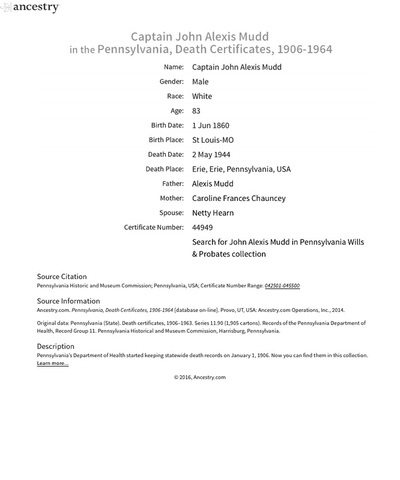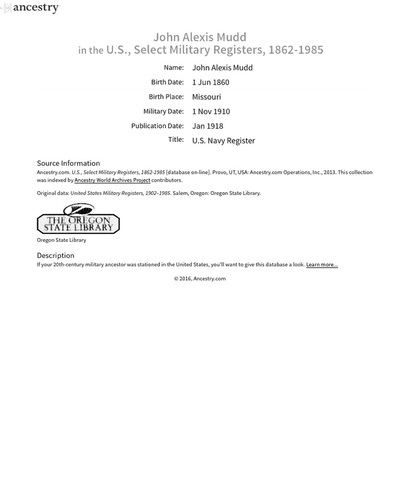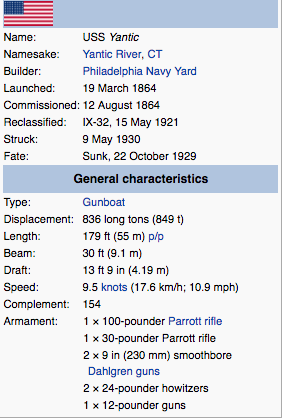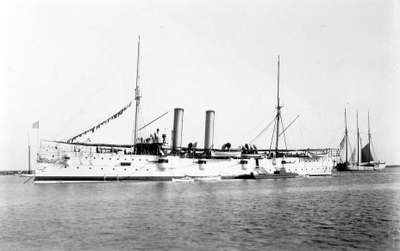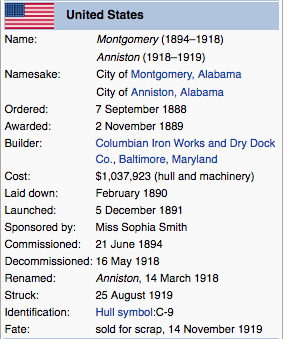1898 NAVY WEST INDIES CAMPAIGN MEDAL
#617
"John Alexis Mudd - Paymaster USN"
"John Alexis Mudd - Paymaster USN"
Captain John Alexis Mudd
United States Navy Captain John Alexis Mudd was born June 1, 1860 in St. Louis Missouri. John was appointed the the Naval Academy Sept. 11, 1875, & he graduated as a Cadet Midshipmen in June 1879.
He served with the Alaska Pacific Squadron from 1879 - 1881. He was appointed as Midshipmen June 10, 1881 & served a Special Duty, Navy Department in 1881 & he resigned his Midshipmen Oct. 28, 1881 & was immediately appointed Assistant Paymaster.
Mudd was stationed at the Yokohama, Japan Naval station in 1881. From 1882 - 1885 he was stationed on the U.S.S. Vermont at the New York Navy Yard. Mudd was then stationed on the U.S.S. Enterprise and sailed with the European Squadron from 1885-1887.
Mudd was back stationed on the U.S.S. Vermont from 1887-1890. In 1891 Mudd was stationed on the U.S.S. Constellation Sloop of War "Practice Ship". John Mudd passed Assistant Paymaster on Jan. 19, 1892 while serving on the U.S.S. Yantic in the South Atlantic Squadron. Mudd was stationed on the U.S.S. Michigan on the Great Lakes in 1893 & then in 1894 - 1896 the U.S.S. Montgomery, North Atlantic Squadron.
He was appointed as Paymaster Nov. 1, 1896. From 1896 - 1900 Paymaster Mudd was stationed at the New York Navy Yard. He was also on a temporary Duty at the Naval Station at Key West in 1898. This is the service that would have qualified him for the West Indies Medal. He was discharged from the Navy Nov. 1, 1910.
Captain Mudd re-enlisted in the U.S. Navy during World War I on March 24, 1917. He then retired from the Navy Jan. 2, 1918 & passed away May 2, 1944 in Erie Pennsylvania.
He served with the Alaska Pacific Squadron from 1879 - 1881. He was appointed as Midshipmen June 10, 1881 & served a Special Duty, Navy Department in 1881 & he resigned his Midshipmen Oct. 28, 1881 & was immediately appointed Assistant Paymaster.
Mudd was stationed at the Yokohama, Japan Naval station in 1881. From 1882 - 1885 he was stationed on the U.S.S. Vermont at the New York Navy Yard. Mudd was then stationed on the U.S.S. Enterprise and sailed with the European Squadron from 1885-1887.
Mudd was back stationed on the U.S.S. Vermont from 1887-1890. In 1891 Mudd was stationed on the U.S.S. Constellation Sloop of War "Practice Ship". John Mudd passed Assistant Paymaster on Jan. 19, 1892 while serving on the U.S.S. Yantic in the South Atlantic Squadron. Mudd was stationed on the U.S.S. Michigan on the Great Lakes in 1893 & then in 1894 - 1896 the U.S.S. Montgomery, North Atlantic Squadron.
He was appointed as Paymaster Nov. 1, 1896. From 1896 - 1900 Paymaster Mudd was stationed at the New York Navy Yard. He was also on a temporary Duty at the Naval Station at Key West in 1898. This is the service that would have qualified him for the West Indies Medal. He was discharged from the Navy Nov. 1, 1910.
Captain Mudd re-enlisted in the U.S. Navy during World War I on March 24, 1917. He then retired from the Navy Jan. 2, 1918 & passed away May 2, 1944 in Erie Pennsylvania.
u.S.S. Vermont
USS Vermont (1848) was originally intended to be a ship of the line for the U.S. Navy when laid down in 1818, but was not commissioned until 1862, when she was too outdated to be used as anything but a stores and receiving ship.
Built at the Boston Navy Yard, Vermont was one of nine 74-gun warships authorized by United States Congress on 29 April 1816. She was laid down at the Boston Navy Yard in September 1818, finished about 1825, and kept on the stocks until finally launched at Boston, Massachusetts on 15 September 1848 in the interest of both space and fire safety considerations. However Vermont was not commissioned at this time. Instead the already aged ship-of-the-line remained in ordinary at Boston until the outbreak of the American Civil War in April 1861.
Post-war service, Vermont remained at the Brooklyn Navy Yard in New York City for the next 37 years, serving both as a store and receiving ship. She was condemned and struck from the Navy list on 19 December 1901 and was sold at New York on 17 April 1902.
Built at the Boston Navy Yard, Vermont was one of nine 74-gun warships authorized by United States Congress on 29 April 1816. She was laid down at the Boston Navy Yard in September 1818, finished about 1825, and kept on the stocks until finally launched at Boston, Massachusetts on 15 September 1848 in the interest of both space and fire safety considerations. However Vermont was not commissioned at this time. Instead the already aged ship-of-the-line remained in ordinary at Boston until the outbreak of the American Civil War in April 1861.
Post-war service, Vermont remained at the Brooklyn Navy Yard in New York City for the next 37 years, serving both as a store and receiving ship. She was condemned and struck from the Navy list on 19 December 1901 and was sold at New York on 17 April 1902.
U.S.S. Enterprise
USS Enterprise, (1877-1909) a 1375-ton (displacement) steam sloop of war built at the Portsmouth Navy Yard, Kittery, Maine, was commissioned in mid-March 1877. She performed surveying duties at the mouth of the Mississippi River and in South American rivers during the next year and a half. Late in 1878 Enterprise began a tour in European waters. When this ended in the spring of 1880 she was laid up at the Washington Navy Yard. After returning to active service early in 1883, the ship operated along the U.S. East Coast for nearly a year, then began a world-wide hydrographic cruise that lasted until March 1886. Her next deployment, from January 1888 to March 1890, took Enterprise to Europe, the Mediterranean and along Africa's Atlantic coast.
Enterprise was employed in the Caribbean and western Atlantic during much of 1890 and 1891, then spent a year on training duty at the U.S. Naval Academy. In October 1892 she became a martime schoolship for the Commonwealth of Massachusetts, an assignment that lasted until May 1909. USS Enterprise was sold in October 1909 and subsequently broken up.
Enterprise was employed in the Caribbean and western Atlantic during much of 1890 and 1891, then spent a year on training duty at the U.S. Naval Academy. In October 1892 she became a martime schoolship for the Commonwealth of Massachusetts, an assignment that lasted until May 1909. USS Enterprise was sold in October 1909 and subsequently broken up.
U.S.S. Constellation
USS Constellation, constructed in 1854, is a sloop-of-war/corvette and the second United States Navy ship to carry the name. According to the U.S. Naval Registry the original USS Constellation was disassembled on 25 June 1853 in Gosport Navy Yard in Portsmouth, Virginia, and the sloop-of-war/corvette was constructed in the same yard using material salvaged from the earlier ship. Constellation is the last sail-only warship designed and built by the Navy. Despite being a single-gundeck "sloop," she is actually larger than her frigate namesake, and more powerfully armed with fewer but much more potent shell-firing guns.
The sloop was launched on 26 August 1854 and commissioned on 28 July 1855 with Captain Charles H. Bell in command. She remained in service for close to a century before finally being retired in 1954, and preserved as a museum ship in Baltimore, Maryland, where she remains today.
After the Civil War, Constellation saw various duties such as carrying exhibits to the 1878 Exposition Universelle in Paris and famine relief stores in the 1879 Irish famine. She also spent a number of years as a receiving ship (floating naval barracks).
After being used as a practice ship for Naval Academy midshipmen, Constellation became a training ship in 1894 for Naval Training Center Newport, where she helped train more than 60,000 recruits during World War I.
The sloop was launched on 26 August 1854 and commissioned on 28 July 1855 with Captain Charles H. Bell in command. She remained in service for close to a century before finally being retired in 1954, and preserved as a museum ship in Baltimore, Maryland, where she remains today.
After the Civil War, Constellation saw various duties such as carrying exhibits to the 1878 Exposition Universelle in Paris and famine relief stores in the 1879 Irish famine. She also spent a number of years as a receiving ship (floating naval barracks).
After being used as a practice ship for Naval Academy midshipmen, Constellation became a training ship in 1894 for Naval Training Center Newport, where she helped train more than 60,000 recruits during World War I.
U.S.S. Yantic
USS Yantic (IX-32), a wooden-hulled screw gunboat built at the Philadelphia Navy Yard, was launched on 19 March 1864 and commissioned on 12 August 1864, Lieutenant Commander Thomas C. Harris in command. She was named after the Yantic River.
1883–1917
In June 1883, Yantic headed for the coast of Greenland, Comdr. Frank Wildes in command, as tender for the steamer Proteus, the latter carrying the men of the second relief party sent out to search for the exploration party led by Lieutenant Adolphus Greely. After touching at Disco, Upernavik, and Littleton Island, Yantic returned to New York on 29 September 1883. She carried back with her the men of the relief party, led by Lieutenant Garlington, and also the officers and men of Proteus, which had been crushed in heavy ice on 23 July 1883. Unfortunately, neither ship found any trace of the ill-fated Greely expedition.
Yantic "showed the flag" along the eastern seaboard and into the waters of South America and the West Indies from 1884 to 1897. In 1898, she was then loaned to the naval militia of the state of Michigan and served as training ship on the Great Lakes until 1917.
1883–1917
In June 1883, Yantic headed for the coast of Greenland, Comdr. Frank Wildes in command, as tender for the steamer Proteus, the latter carrying the men of the second relief party sent out to search for the exploration party led by Lieutenant Adolphus Greely. After touching at Disco, Upernavik, and Littleton Island, Yantic returned to New York on 29 September 1883. She carried back with her the men of the relief party, led by Lieutenant Garlington, and also the officers and men of Proteus, which had been crushed in heavy ice on 23 July 1883. Unfortunately, neither ship found any trace of the ill-fated Greely expedition.
Yantic "showed the flag" along the eastern seaboard and into the waters of South America and the West Indies from 1884 to 1897. In 1898, she was then loaned to the naval militia of the state of Michigan and served as training ship on the Great Lakes until 1917.
U.S.S. Michigan
USS Michigan was the United States Navy's first iron-hulled warship and served during the American Civil War. She was renamed USS Wolverine in 1905.
The side wheel steamer Michigan was built in response to the British Government arming two steamers in response to the Canadian rebellions in the late 1830s with Secretary of the Navy Abel P. Upshur selecting an iron hull partly as a test of practicability of using such a "cheap and indestructible a material" for ships. The ship was designed by Samuel Hart, and fabricated in parts at Pittsburgh in the last half of 1842, transported overland and assembled at Erie. The launch on 5 December 1843 was unsuccessful with the ship sticking after moving some 50 feet (15.2 m) down the ways and efforts to complete the launch ended by nightfall. On returning in the morning Hart found Michigan had launched "herself in the night" and was floating offshore in Lake Erie.
By 1908 the ship was noted in the journal The American Marine Engineer as being the oldest metal hulled vessel then existing and of interest to engineers because of the ship's age. The two engines were inclined simple steam engines of 36 inches (91.4 cm) with a 96 inches (243.8 cm) stroke that were original and running well in 1908. The first of three sets of boilers were return flue type that lasted fifty years before finally being replaced by bricked in return tube types. The operating pressure was low, 25 pounds (11.3 kg) sufficient to drive the engines at 20 rpm, with engine room piping of .125 inches (0.318 cm) thick copper connecting with brass flange joints. When, about 1905, the ship finally changed from kerosene lights to electric a special engine for the dynamo had to be constructed to operate on the low pressure steam. The steam was also used in a peculiar system for repelling boarders with hot water direct from the boiler. Coal consumption before the latest modifications was two tons per hour and after the modifications was as low as one half ton per hour. The ship carried two steam launches. The ship had never made even ten knots until dispatched from the harbor at Cleveland to Buffalo to prevent riots on the assassination of President William McKinley 6 September 1901 and, with the safeties weighted, she made almost fourteen knots at 30 rpm at one point.
After the Civil War, Michigan remained in U.S. Navy service, and was the ship which intercepted and interned the army of the Fenian Brotherhood as it returned from its invasion of Canada near Buffalo in 1866. Michigan was renamed USS Wolverine on 17 June 1905 to free up the name Michigan for use by the new battleship USS Michigan (BB-27).
The side wheel steamer Michigan was built in response to the British Government arming two steamers in response to the Canadian rebellions in the late 1830s with Secretary of the Navy Abel P. Upshur selecting an iron hull partly as a test of practicability of using such a "cheap and indestructible a material" for ships. The ship was designed by Samuel Hart, and fabricated in parts at Pittsburgh in the last half of 1842, transported overland and assembled at Erie. The launch on 5 December 1843 was unsuccessful with the ship sticking after moving some 50 feet (15.2 m) down the ways and efforts to complete the launch ended by nightfall. On returning in the morning Hart found Michigan had launched "herself in the night" and was floating offshore in Lake Erie.
By 1908 the ship was noted in the journal The American Marine Engineer as being the oldest metal hulled vessel then existing and of interest to engineers because of the ship's age. The two engines were inclined simple steam engines of 36 inches (91.4 cm) with a 96 inches (243.8 cm) stroke that were original and running well in 1908. The first of three sets of boilers were return flue type that lasted fifty years before finally being replaced by bricked in return tube types. The operating pressure was low, 25 pounds (11.3 kg) sufficient to drive the engines at 20 rpm, with engine room piping of .125 inches (0.318 cm) thick copper connecting with brass flange joints. When, about 1905, the ship finally changed from kerosene lights to electric a special engine for the dynamo had to be constructed to operate on the low pressure steam. The steam was also used in a peculiar system for repelling boarders with hot water direct from the boiler. Coal consumption before the latest modifications was two tons per hour and after the modifications was as low as one half ton per hour. The ship carried two steam launches. The ship had never made even ten knots until dispatched from the harbor at Cleveland to Buffalo to prevent riots on the assassination of President William McKinley 6 September 1901 and, with the safeties weighted, she made almost fourteen knots at 30 rpm at one point.
After the Civil War, Michigan remained in U.S. Navy service, and was the ship which intercepted and interned the army of the Fenian Brotherhood as it returned from its invasion of Canada near Buffalo in 1866. Michigan was renamed USS Wolverine on 17 June 1905 to free up the name Michigan for use by the new battleship USS Michigan (BB-27).
USS Montgomery
The fourth USS Montgomery (C-9), the lead ship of her class, was an unprotected cruiser in the United States Navy authorized in the Naval Appropriations Act of September 7, 1888. Montgomery served during the Spanish–American War and in World War I and was named for Montgomery, Alabama.
Montgomery was launched 5 December 1891 by Columbian Iron Works, Baltimore, Maryland; sponsored by Miss Sophia Smith; and commissioned at Norfolk Navy Yard 21 June 1894, Commander Charles W. Davis in command.
Assigned to the North Atlantic Squadron, the new cruiser operated along the eastern seaboard and in the Caribbean. During the Spanish-American War, she cruised near Cuba and Haiti in April 1898 and in May joined the blockade of Havana. She took two prizes, Lorenzo and Frasquito, 5 May, and shelled the Spanish forts a week later. On 13 June a 280mm Krupp gun at the Santa Clara Battery fired on Montgomery, at a range of 9,000 meters, apparently without effect.
In April 1899 Montgomery transferred to the South Atlantic Squadron and operated along the Atlantic coast of South America until returning to the United States and decommissioning at New York City 15 September 1900. Recommissioned 15 May 1902, she was assigned to the Caribbean Division, North Atlantic Squadron, and operated in the West Indies until decommissioning at Philadelphia, Pennsylvania 15 September 1904.
Montgomery recommissioned 2 January 1908 and operated in the 5th Naval District as a torpedo experimental ship. From 1914 to 1918 she served with the Maryland Naval Militia. Renamed Anniston 14 March 1918, she was assigned to Division 2, American Patrol Detachment, for patrol and escort duty along the Atlantic coast and in the Caribbean.
Decommissioning at Charleston, South Carolina, 16 May 1918, Anniston was struck from the Navy list 25 August 1919 and sold 14 November 1919.
Montgomery was launched 5 December 1891 by Columbian Iron Works, Baltimore, Maryland; sponsored by Miss Sophia Smith; and commissioned at Norfolk Navy Yard 21 June 1894, Commander Charles W. Davis in command.
Assigned to the North Atlantic Squadron, the new cruiser operated along the eastern seaboard and in the Caribbean. During the Spanish-American War, she cruised near Cuba and Haiti in April 1898 and in May joined the blockade of Havana. She took two prizes, Lorenzo and Frasquito, 5 May, and shelled the Spanish forts a week later. On 13 June a 280mm Krupp gun at the Santa Clara Battery fired on Montgomery, at a range of 9,000 meters, apparently without effect.
In April 1899 Montgomery transferred to the South Atlantic Squadron and operated along the Atlantic coast of South America until returning to the United States and decommissioning at New York City 15 September 1900. Recommissioned 15 May 1902, she was assigned to the Caribbean Division, North Atlantic Squadron, and operated in the West Indies until decommissioning at Philadelphia, Pennsylvania 15 September 1904.
Montgomery recommissioned 2 January 1908 and operated in the 5th Naval District as a torpedo experimental ship. From 1914 to 1918 she served with the Maryland Naval Militia. Renamed Anniston 14 March 1918, she was assigned to Division 2, American Patrol Detachment, for patrol and escort duty along the Atlantic coast and in the Caribbean.
Decommissioning at Charleston, South Carolina, 16 May 1918, Anniston was struck from the Navy list 25 August 1919 and sold 14 November 1919.












